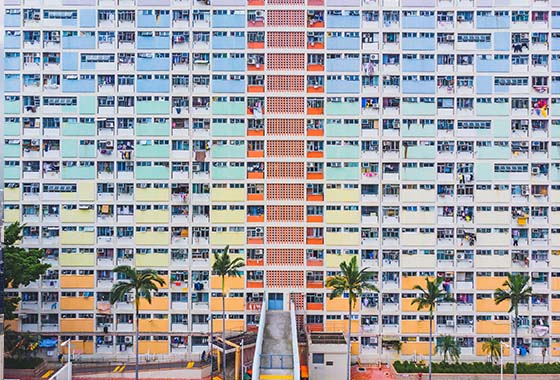OHKF 10-Year Housing Supply Forecast 2023
Our Hong Kong Foundation
10-Year Housing Supply Forecast 2023
(27 April 2023, Hong Kong) Our Hong Kong Foundation (OHKF) released its latest exclusive public and private housing supply forecast today. Driven by the new Administration’s policy measures, a significant improvement in supply is expected for the next five years. The Composite Waiting Time for Subsidised Rental Housing (CWT) could be shortened to 4.6 years by 2026/27, while the annual completion of private housing units is anticipated to reach 19,000 units during 2023-2027. Looking forward, the Government should seize the opportunity to release the untapped development potential of the Northern Metropolis to ensure achieving its ten-year target in the Long Term Housing Strategy (LTHS).
Public Housing Supply: Waiting Time Could Shorten Subject to the Supply Target Being Attained
A shorter waiting time hinges on added supply boost in the next five years. On the premise of the timely delivery of an extra 30,000 Light Public Housing (LPH) units, the total public housing completions per year for the five-year period from 2023 to 2028 would be increased to 31,700 units, thus achieving the LTHS annual target. The CWT is likely to be shortened from its peak at 6.1 years in 2021/22 to 4.6 years by 2026/27, which is close to achieving the Government’s key performance indicator (KPI). Therefore, the LPH will be instrumental in supplementing the short-term public housing supply.
The ten-year target is within range as uncertainties surrounding the “back-loaded” supply have been reduced. The Government first announced last year the public housing sites estimated to be completed in the second five-year period (2028/29 to 2032/33). Given this improved information transparency and the measures enhancing construction efficiency set out in the Policy Address to reduce recurrent delays, OHKF expects approximately 360,000 units to be completed in the next 10 years (2023/34 to 2032/33). Apart from meeting all potential housing supply stated in the Policy Address, this will exceed the LTHS target by 20%.
Risks from rezoning need to be removed in anticipation of the Northern Metropolis emerging as the supply powerhouse. But challenges do exist in meeting the supply targets. The projected housing supply in the second five-year period contributes to two-thirds of the ten-year total supply target, where as high as 60% of which would come from the Northern Metropolis. Meanwhile, half of this 60% belongs to scattered rezoning lands such as brownfield clusters. Various complications could be expected including the possible extended time on land resumptions and clearance procedures. OHKF recommends that the Government carefully formulate accurate resettlement strategies in advance to mitigate any risk of delay.
Private Housing Supply: Positive Trend for the First Five Years but Tailing off in the Next
Supply remains high in the first five years corroborated by positive trends in leading indicators. Assuming the successful implementation of favourable policy measures such as streamlining development procedures, OHKF expects the completion of private housing units to reach around 19,000 units a year in the next five years (2023-2027). This is an upward revision against our previous five-year rolling estimate. Positive trends on leading indicators such as pre-sale consent applications and building construction also offered validation to OHKF’s estimation.
Despite an improved ten-year supply outlook, the shortage of spade-ready sites hints at a gradual flatlining. An average annual completion of 13,900 private housing units is expected in the second five-year period (2028-2032). The figure aligns with the upper-bound scenario in OHKF’s forecast last year and exceeds the LTHS average annual target. Nevertheless, it represents a 30% drop when compared with the first five-year period. In fact, the sharp decline in spade-ready land supply for private housing since 2017/18 has foreshadowed the slump in completion level five years from now.
Comprehensive development of the Northern Metropolis is needed to unleash housing potential and stabilise future supply. In addition to known projects, many private development projects in the Northern Metropolis are undergoing planning applications. There is a high degree of overlap between their geographical distribution and the potential developable areas identified in OHKF’s previous report Building a Global City of the Future – Envisioning Sustainable Urbanisation of the New Territories published in July 2021. However, to unleash the development potential in these areas, the Government must tackle the challenges in traffic, sewage, conservation, and NIMBY (not-in-my-backyard) facilities. The Northern Metropolis will be a decisive factor for boosting the private housing completion level in the second five-year period.
Decoding Market Dynamics: Changes in Market Preference with Reduced Attractiveness of Small-size Units
Favourable factors have led to increased options for buyers, reducing the need to forego living space for smaller price tag. Smaller units do have their edge in terms of down payment and affordability. However, following the Government’s relaxation on the mortgage rules and increased supply of subsidised housing, buyers’ purchasing power and housing options increased, which considerably reduced the attractiveness of smaller units. Since 2020, the sales ratio of mid-size units has overtaken smaller units, with the gap further widened last year. The earlier trend of first-time buyers scrambling for units with a smaller lump sum, irrespective of size, to get a foothold in the property ladder is retreating.
Nano- and small-size units’ domination to cease, with mid-size units to be the future mainstream. The gradual decline in popularity of smaller units will extend from the sales phase to the upstream design and construction stage. OHKF anticipates the proportion of smaller units in new private housing completions to reach its peak this year and more mid-size units will be completed after 2024. As for nano-flats, since there are units with construction commenced before the imposition of the minimum flat size requirement by the Government, their completions are expected to rise but will plateau from 2024 to 2025.
Laying Foundations Through Fulfilling Basic Housing Needs and Propel Hong Kong to Realise its Vision as a Liveable City
With basic housing needs yet to be fully met, it is imperative for the Government to strictly adhere to its housing supply strategy, shorten the CWT over the next five years, and achieve the LTHS public and private housing supply targets in the next ten years. It is by doing so that a solid foundation can be laid to enhance Hong Kong’s living quality and gradually head toward a more livable city.
OHKF President Dr Jane Lee said: “With pandemic restrictions finally behind us, together with the Government's new policies and measures, we are seeing an improvement in the housing supply outlook. However, we must remain vigilant. People living in sub-divided flats are still waiting for better housing, many residents from the sandwich class and young families are still longing for home ownership. OHKF’s annual housing supply analysis aims to help the public stay informed of the latest demand and supply trends and provide a direction to guide Hong Kong to a liveable city.”
OHKF Vice President & Co-Head of Research Mr Ryan Ip remarked: “To ensure that the public and private housing supply targets are met in the next decade, the keys hinge on expediting the development of the Northern Metropolis, enhancing the efficiency on land delivery, and increasing the reserve of spade-ready land. OHKF has been making major recommendations, including large-scale urbanisation in the New Territories, streamlining development procedures, and bringing forward transportation and infrastructure construction. We urge the Government to continue these efforts and remain steadfast in implementation. To increase housing supply in the short term and to alleviate the housing challenges facing the grassroots, we see enhancing construction efficiency, popularising the use of Modular Integrated Construction (MiC) method, as well as constructing transitional housing and LPH units, are all sound options at present.”
Full Report of 10-Year Housing Supply Forecast 2023:
Chinese:https://bit.ly/3LzeSn0
English:https://bit.ly/3Lw5lwW




